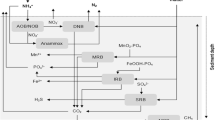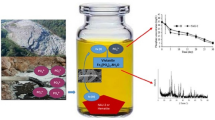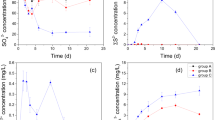Abstract
Nitrate-reducing bacteria (Pseudomonas fluorescens andAlcaligenes sp.) as well as extracellular compounds from these bacteria increased the dissolution rate of iron and phosphorus sorbed to iron precipitates during anaerobic, nitrate-free conditions in experimental sediment-water systems. It is suggested that the influence of the bacteria is due to enzymatic catalyzation of chemical iron reduction.
Similar content being viewed by others
References
Ahl T (1979) Natural and human effects of trophic evolution. Arch Hydrobiol BH 43:259–279
Andersen JM (1982) Effect of nitrate concentration in lake water on phosphorus release from lake sediment. Water Res 16:1119–1126
Boström B (1982) Potential mobility of phosphorus in lake sediments of different character. Thesis, University of Uppsala, Sweden
Boström B, Jansson M, Forsberg C (1982) Phosphorus release from lake sediments. Arch Hydrobiol Beih Ergebn Limnol 18:5–59
Einsele W (1938) Über chemische und kolloidchemische Vorgänge in Eisen-Phosphat-Systemen unter limnologischen und limnogeologischen Gesichtspunkten. Arch Hydrobiol 33:361–387
Golterman HL (1975) Physiological limnology. Elsevier, Amsterdam
Hasler AD (1947) Eutrophication of lakes by domestic drainage. Ecology 28:383–393
Jansson M (1986) Nitrate as a catalyst for phosphorus mobilization in lake sediments. In: Sly PA (ed) Sediments and water interactions. Springer-Verlag, New York, pp 382–387
Jones JG, Gardener S, Simon BM (1983) Bacterial reduction of ferric iron in a stratified eutrophic lake. J Gen Microbiology 129:131–139
Kino K, Usami S (1982) Biological reduction of ferric iron by iron- and sulfur-oxidizing bacteria. Agric Biol Chem 46:803–805
Lascelles J, Burke K (1978) Reduction of ferric iron by L-lactate and DL-glycerol-3-phosphate in membrane preparations fromStaphylococcus aureus and interactions with the nitrate reductase system. J Bacteriol 134:585–589
Mortimer CH (1941) The exchange of dissolved substances between mud and water in lakes (parts I and II). J Ecol 29:280–329
Munch JC, Ottow JCG (1980) Preferential reduction of amorphous to crystalline iron oxides by bacterial activity. Soil Sci 129:15–21
Munch JC, Hillebrand T, Ottow JCG (1978) Transformations in the Feo/Fed-ratio of pedogenic iron oxides affected by iron-reducing bacteria. Can J Soil Science 58:475–486
Munch JC, Ottow JCG (1983) Reductive transformation mechanism of ferric oxides in hydromorphic soils. Ecol Bull 35:383–394
Neilands JB (1973) Microbial iron transport compounds (siderochromes). In: Eichhorn (ed) Inorganic biochemistry. Elsevier, Amsterdam pp 167–202
Obuekwe CO, Westlake DWS (1981) Effect of nitrate on reduction of ferric iron by a bacterium isolated from crude oil. Can J Microbiol 27:692–697
Ohle W (1937) Kolloidgele als Nährstoffregulanten der Gewässer. Naturwissenschaften 25: 471–474
Ottow JCG (1970) Selection, characterization and iron-reducing capacity of nitrate reductaseless (nit−) mutants from iron-reducing bacteria. Z Allg Mikrobiol 8:441–443
Ottow JCG, Glathe H (1971) Isolation and identification of iron-reducing bacteria from gley soils. Soil Biol Biochem 3:43–55
Rodhe W (1969) Crystallization of eutrophication concepts in northern Europe. In: Rohlich GA (ed) Eutrophication: causes, consequences and correctives. National Academy of Sciences, Washington, D.C., pp 50–64
Sørensen J (1982) Reduction of ferric iron in anaerobic, marine sediment and interaction with reduction of nitrate and sulfate. Appl Environm Microbiol 43:319–324
Stumm W, Morgan JJ (1970) Aquatic chemistry. Wiley-Interscience, New York
Tessenow U (1975) Lösungs-, Diffusions- und Sorptionsprozzesse in der Oberschicht von Seesedimenten. Arch Hydrobiol Suppl 47:325–412
Author information
Authors and Affiliations
Rights and permissions
About this article
Cite this article
Jansson, M. Anaerobic dissolution of iron-phosphorus complexes in sediment due to the activity of nitrate-reducing bacteria. Microb Ecol 14, 81–89 (1987). https://doi.org/10.1007/BF02011573
Issue Date:
DOI: https://doi.org/10.1007/BF02011573




